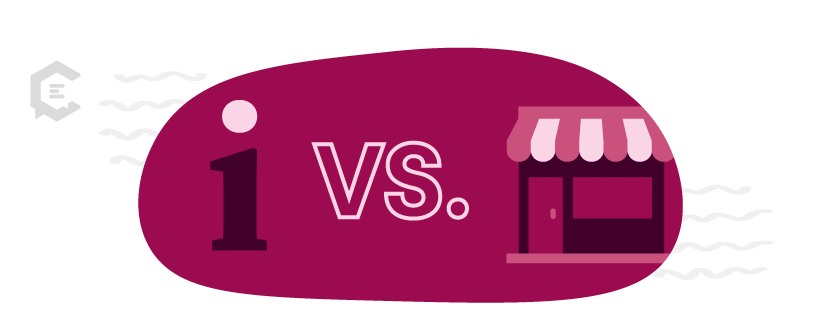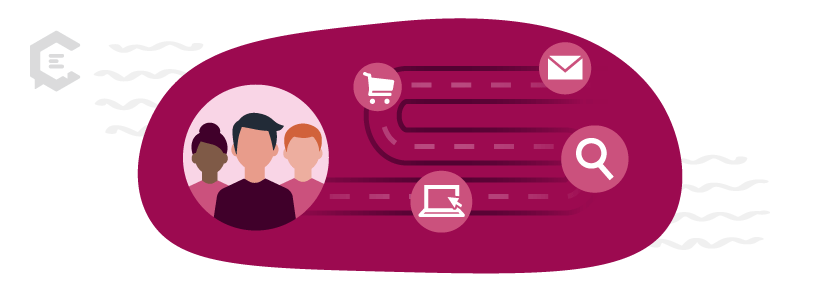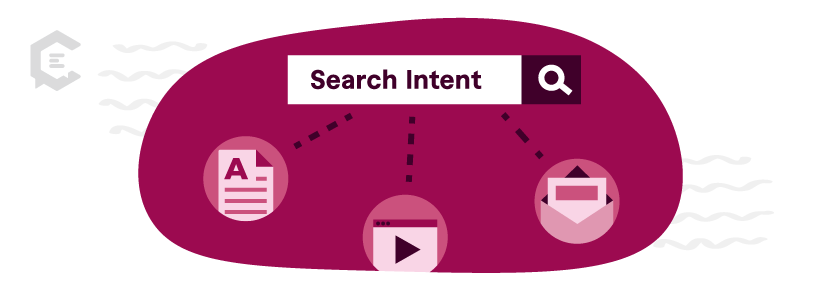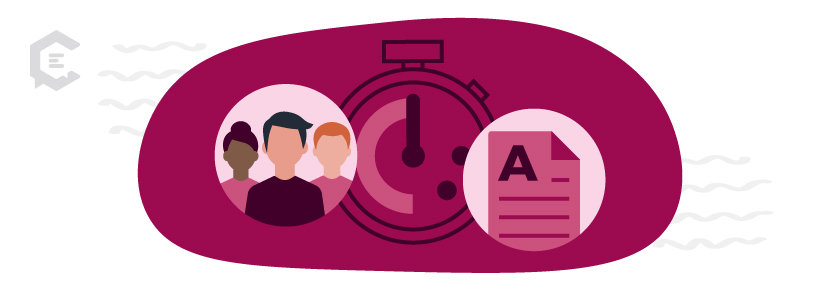Experienced content marketing professionals know they need to first understand the customer intention behind their content and then optimize it for the user’s needs and wants. Writing for customer intent includes the structure and depth of the content, vocabulary, call to action, and more.
Nailing the intention makes it much easier to rank higher in search engine results pages (SERPs) for particular keywords.

Writing for customer intent = understanding your audience
When writing for customer intent, it’s necessary to understand the purpose behind a customer or user’s search. It generally breaks down into one of two intentions: commercial or informational. A user’s search intent answers the crucial question behind that search behavior: Why?
For example, when someone searches Google for the keyword running, what exactly are they looking for? Do they want to improve their form? Are they thinking about beginning a running program for the first time? Are they shopping for running gear?
The answer to the question of why is key to understanding what specific content a particular searcher wants to find. It’s also the key to what search engines want. Responsive content to user intention is the kind of content search engines reward with higher rankings. In general, your content will rank higher if it corresponds to and fulfills the true searcher’s intentions.
The first step is to understand two broad content categories:
- Informational content is designed to educate and inform. It’s not meant to persuade users to complete a purchase, so conversions into sales or revenue aren’t the goal — at least, not yet.
- Commercial content is crafted to persuade the reader to buy from your brand. For commercial content, a conversion action is closer to or at the point of purchase.
Informational content vs. commercial content examples
Let’s stay with the running example.
Informational content example
An informational keyword for this topic could be something like how to start running. There are plenty of articles available that answer the informational intention behind that how-to phrase, one of which is an article from FleetFeet.com. It styles itself as a beginner’s guide for starting a running program.
The content on the pages covers a wide variety of topics of interest to a beginning runner, including nutrition, proper running form, and running gear. Yet, it’s purely educational and aimed solely at informing the beginner runner so they can set and achieve their specific running goals.
Commercial content example
Now let’s examine another long-tail keyword related to running: best running shoes for flat feet. That same website also has a top-10-ranked article for the same long-tail keyword.
The content on that page aligns with the commercial intent of the search phrase. The call to action is positioned immediately beneath its headline: “Shop All Running Shoes.”
While the content that follows is certainly educational and helpful to a beginning runner, it’s designed to help match up a ready and willing buyer with the right brand of the product they’re looking for — shoes for runners with flat feet.
Also note the way the page’s navigation is organized by a list of links to sections within the content, each anchored to six specific recommended brand names.

User intentions and the buyer’s journey
You might have noticed by now that your user’s search intention actually aligns pretty well with their steps along your buyer’s journey.
As a refresher, here’s a quick summary of the typical three-stage buyer’s journey for most brands:
- Awareness: At the top of the funnel (or TOFU), your users seek to educate themselves about a need, goal, challenge, or interest.
- Consideration: The next stage represents the middle of the funnel (MOFU), where the user is primed to take action with respect to that goal or challenge and is looking for a targeted set of directions on how to accomplish that goal.
- Decision: At the bottom of the funnel (BOFU), your searcher/user is ready to make a commitment to a specific purchase. They’re evaluating a list of options but will be “buying now” in fairly short order.
When writing for customer intent, the three-step buyer’s journey should only be seen as a template. Users, however, take a variety of paths toward completing a purchase with your brand, and each journey may have dozens of steps that leapfrog through the template journey. A user may also jump straight from seeking information to completing a purchase.
However, the earlier TOFU steps align with informational searches. As users become more aware of their challenges or goals, they look to educate themselves. They’re looking for authoritative content that reveals the challenges to them in more detail, as well as potential paths and solutions.
As they move down the funnel and closer to a purchase decision, their intentions shift from informational to commercial. Once they’re ready to buy, their searches will be aimed at finding the best deal, ensuring they’re dealing with a reputable vendor, and securing value-added bonuses such as free shipping or extended warranties.
Buyer personas, buyer journeys, and search intent
It’s important to keep buyer journey models and buyer personas distinct when writing for customer intent. While developing accurate buyer personas will help your marketing hit its target markets precisely, those persona profiles aren’t the same thing as the buyer’s journey for your brand. Each persona may take a different path on the way to a completed purchase.
However, buyer personas may impact the way their search intent is expressed. For example, members of the baby boomer generation will use different vocabulary in formulating their searches than millennials or Gen Y shoppers. Younger consumers will expect their results to be optimized for mobile devices, while older searchers may be more oriented towards desktops or laptops.

Search intent and content types
In addition to the general substance, the format or type of content can also vary between informational and commercial pages. Aligning the content type with the intention helps you create a better user experience on your site’s page. That in turn increases the user’s time on your site, which boosts your positioning in search results.
Your content should always be oriented towards the needs of the search user. For informational content, that means tightly organized, hierarchical pieces. For example, if you’re writing that introduction to running, your outline might look something like this:
- Benefits of running
- Physical health
- Mental health
- Conditioning
- Proper form
- Running gear
Using proper HTML tags (PDF) will help each reader scan, read, and process the content you’re providing. In this case, your top levels in the outline would be H2 tags in your content. “Physical health” and “Mental health” would be H3 tags nested into the “Benefits” section. You can also experiment with more visual forms of content when writing for customer intent as well, including infographics and slide decks.
For commercial content, the searcher is looking for direction and recommendations to help them choose a solution. A buyer’s guide is ideal, as is an in-depth review and comparison of two or three top-recommended choices. Offering discount codes, free trial periods, and other value-added bonuses within the content will help nudge the user to move from shopper to paying customer.
Keywords and customer intention
A customer’s search intention is generally reflected in the way they phrase their search. The specific language of the keyword or search query will help you figure out the intention behind the search.
As a general rule, longer tail searches reflect a position that’s further down the funnel and thus closer to a commercial intention. When a customer is ready to purchase, they’re usually interested in answering specific questions and researching brand and product recommendations. Consequently, commercial intent searches generally include brand names (exact matches) or more precise product/service descriptions, together with words like:
- Discount
- Coupon code (or promo code)
- Buy now
- Free shipping
- Buyer’s guide
Informational content searches, by contrast, tend to reflect shorter-tail search queries. Think running shoes instead of best running shoes for women with flat feet or how to start running instead of best nutritional supplements for beginning women runners. These searches may also include words such as:
- How to
- Tutorial
- What is

How to optimize content based on customer intention
Writing for customer internet means addressing the needs of your target audience and reviewing the content of your page to see if it can be optimized. Look for ways to make your word choice, structure, and format more aligned with your customer’s needs.
For informational content, double-check to make sure you’ve met the following requirements:
- Avoid sales pressure completely
- Minimize or eliminate brand mentions
- Answer specific questions users are researching and asking
- Include responsive informational terms such as “tutorial” and “how-to” and “what is”
For content that responds to commercial user intent, use the following optimization checklist:
- Create persuasive content that expresses your company’s unique value proposition
- Include brand names and help the customer make the right choice between those brands.
- Craft a compelling and highly focused call to action, such as the shop for running shoes button in the FleetFeet.com example above.
- Include commercially responsive words like discount, coupon code, and free shipping.
Help your content match the customer’s intention
You will achieve higher ranking in search results if you write, organize, and format content that aligns with your user’s search intent, as well as raising your brand’s visibility among interested shoppers.
Remember to always include a call to action that aligns with the intent. Commercial content can take a buy now or sign up for a free trial button, while informational content should aim to encourage subscriptions to your email list in exchange for additional informational content so you can capture a new lead.
Talk to a content specialist about developing content that matches your customers’ intentions today. From top of the funnel to bottom, get a content strategy that moves your audience along every stage of the customer journey.



